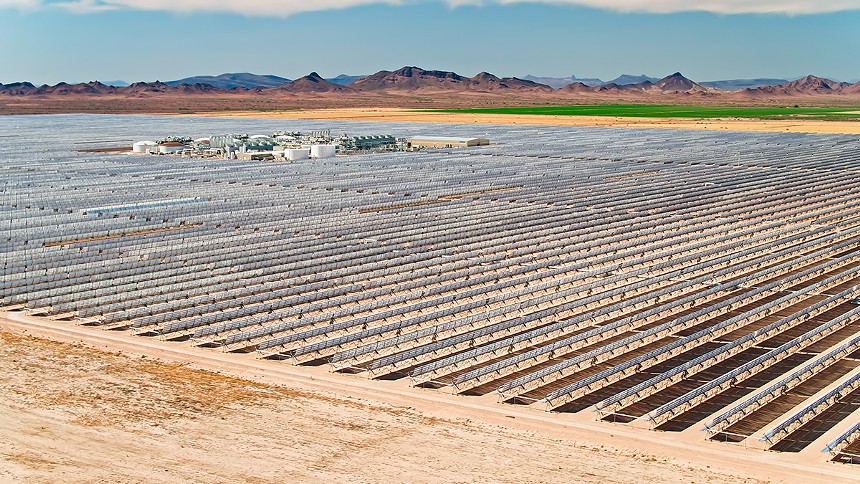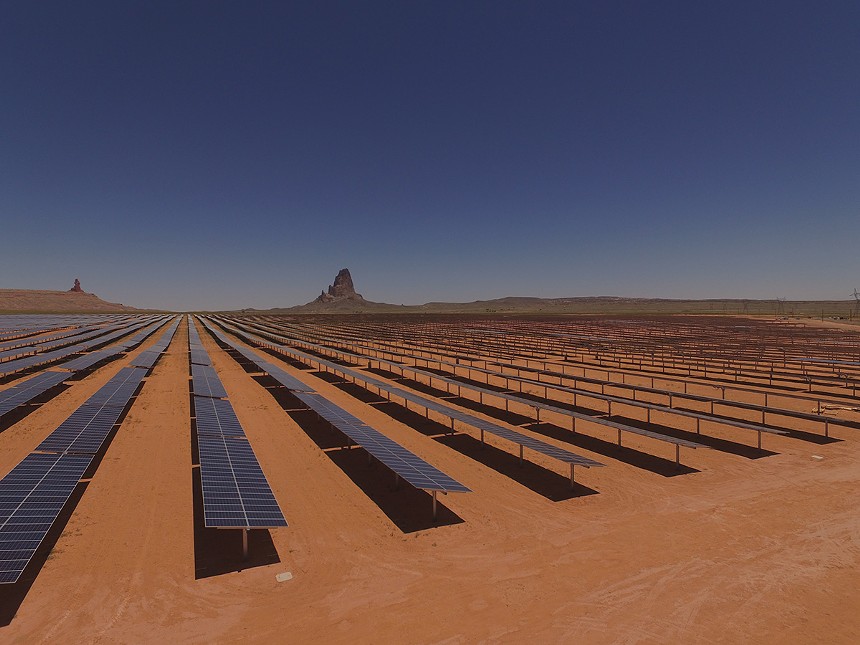Arizona has more than 300 days of sunshine annually, 12 percent more of it than 30 years ago, thanks to climate change.
For most Arizonans it's a case of sunshine, sunshine everywhere, and not a drop to power their homes.
Barely 8 percent of the energy powering the Grand Canyon State comes from the sun's rays.
By that calculation, Massachusetts harnesses more sunlight than Arizona, with 20 percent of that state's power generation stemming from solar despite having 197 sunny days each year, below the national average.
Arizona is a top generator of solar power, but it doesn't trickle down to the residential electric customers because a quarter of it is sold to utilities in other states, especially Nevada and California.
When individuals try to break free of the utility company's grip over their electric bill by installing solar it can be a difficult hurdle to jump. That's by design, advocates claim.
"In Arizona, people understand that solar is here. They understand that solar works," said Bret Fanshaw, director of Solar United Neighbors of Arizona.
"They largely want solar. But they can't get it."

Fanshaw heads up Arizona's chapter of a national nonprofit based in Washington, D.C., that advocates for an equitable energy system with rooftop solar as the cornerstone.
Advocates, industry workers, consumers, and even courts largely agree that Arizona's energy system is far from equitable.
According to a recent federal appeals court decision, utility companies such as the Tempe-based Salt River Project may be held liable for antitrust violations such as price-fixing solar products.
Arizonans seeking energy independence by way of rooftop solar were robbed of the chance to control their electric bill, advocates argued.
Judge Eric D. Miller affirmed that SRP "unlawfully discriminated against customers with solar-energy systems and was designed to stifle competition in the electricity market."
Miller sent the case back to a trial judge to determine what damages SRP owes customers.
"SRP does not believe that it is standing in the way of its customers who are choosing rooftop solar," said Patty Garcia-Likens, spokesperson for SRP in a recent email.
The company has long been a political and economic powerhouse in Arizona credited with enabling exponential urban expansion in the Valley since about 1900.
Now, SRP is stymieing rooftop solar to prevent competition, one board member claims.
Randy Miller, who serves on the SRP Association Board which oversees its electric portfolio, said the utility is clinging to both the past and to its enduring role as one counterpart of the Valley's energy duopoly, along with the larger Arizona Public Service Company.
As Miller puts it, "They're like Blockbuster in a world where you want Netflix."
But SRP denies working against the interest of its solar customers and points to its recent activity.
The utility has more than 36,000 rooftop solar customers with 1,000 new monthly applications.
"Based on the current adoption rates, we believe the rate structures are working well," Garcia-Likens said.
What's the Disconnect?
Arizona is the sunniest state in the country. It offers 50 percent more sunshine than the rest of the country.
Solar power generated in Arizona today could power over 950,000 homes.
Add in three proposed utility-scale solar projects currently under consideration in Maricopa County, and that number jumps over 1.1 million homes – more than a third of the 3 million homes in the state.
Demand for utility-scale solar projects has skyrocketed because investors are eager to grab a slice of renewable energy projects such as solar panels. Green bonds, environmentally friendly investments, are being gobbled up on the global bond market. Shareholders, board leaders, and customers of companies have been pushing for corporate goals which align with an environmental, governance, and a more socially responsible future.
Over the years, the cost of large-scale solar projects has declined substantially to the point that it is the cheapest way to produce electricity, even cheaper than natural gas power plants, according to international market analysis business Lazard.
But fewer than 200,000 residential dwellings in Arizona are powered by utility-scale solar energy.
"There's all this solar in Arizona and we're not using it," said Shelley Gordon, a solar panel owner in Mesa and director of Arizonans for Community Choice, a special interest group focused on solar energy.
The solar market in Arizona has remained turbulent since the imposition of a net metering charge in 2014 and the erosion of incentives since, sparking public debate about the benefits of solar.
It's the utility-controlled political machine that sowed doubt and apprehension in the hearts of prospective solar adopters at an early stage, Gordon said.
Arizona residents "lack the confidence to make a decision" on whether or not to go solar, Fanshaw said.
During elections in 2014 and 2016, Arizona Public Service's top executives plotted smear campaigns against pro-solar candidates for the Arizona Corporation Commission, while boosting their anti-solar counterparts. The Commission regulates the utilities.
"APS has spent the last eight years essentially undermining our democracy," former Corporation Commissioner Kris Mayes told Phoenix New Times in 2019.
APS did not respond to requests for comment for this story.
Both Arizona utility giants are culpable for stifling solar, Gordon said.
"The issue is that they see solar as competition," she said. "They see it as something that's going to hurt them."
Where the Power Comes From
The vast majority of Arizona's energy comes from non-renewable sources. Natural gas, nuclear power, and coal provide 88 percent of Arizona's utility-scale electricity net generation.
And despite having the third-least water of any state, Arizona's leading clean energy source is hydroelectric power, thanks to the APS-operated Hoover Dam and Theodore Roosevelt Dam, which is operated by SRP.
Miller, the SRP board member, attributes this to the company's inability to transition to new technology as it becomes available.
Small and cloudy Massachusetts has access to more waterways than almost any other state but hardly uses any hydroelectric power as it emerges as a national leader in solar energy.
SRP has five hydroelectric power plants, which rely on water dams to generate electricity in its portfolio. It has more hydropower in terms of the number of facilities compared to steam and coal-fired power plants.
SRP also remains a major player in the Palo Verde Nuclear Generating Station, about 50 miles west of downtown Phoenix. It's the largest nuclear power plant and the largest net energy producer in the country.
"They want to lock up the monopoly in perpetuity," Gordon said.
Arizona's Navajo Generating Station, the state's second-largest power plant, shut its doors in 2019. It was the only customer of the state's last remaining operating coal mine, which also closed in 2019.
The Navajo Nation's other coal plant in New Mexico which contributes to the Arizona grid through APS is closing, too.
But last month SRP pledged to extend the operation of an existing solar plant in Kayenta through 2038 and to begin construction on a new solar facility in Cameron, which will be functional next year.
SRP General Manager Mike Hummel and Navajo Nation President Jonathan Nez shook hands in Phoenix in late January.
"We need to protect our Mother Earth, the land, air, and water for the next generation," said Navajo Nation Council Delegate Nathaniel Brown.
But that doesn't mean nonrenewable energy is dwindling in Arizona's portfolio.
Next week, SRP will consider adding sixteen more natural gas plants, dubbed "death plants" by board member Miller. Those gas-fired plants are expected to expand an existing generation station in the community of Randolph in Pinal County.
SRP's leadership told ratepayers that increased demand for power in metro Phoenix necessitated the expansion.
This action is a step in the wrong direction, Miller said.
Nationwide, power generation facilities have been built in communities where locals were not always given a chance to participate in the wealth generated such as getting high-paying plant jobs while bearing the brunt of environmental pollution emitted by such a plant.
The mostly Black community of Randolph has lost a significant population over the years. Critics claim that the community as a whole would not likely benefit much economically by doubling the size of its natural gas plant but would potentially breathe more toxic air created by the fossil fuel.
"It's going to be a stranded asset before it's even built," Miller said about the Randolph plant.
Natural gas turbines are necessary to bail out the "fluctuations in output" when relying on wind and solar energy systems, said Hummel.
But the company told ratepayers that a stabilizing dose of nonrenewable energy will also enable it to add more solar power to its portfolio later on.
The expansion "will keep the lights on during times of peak electricity demand in the Valley and help support the variable output from SRP's growing portfolio of renewable resources," Hummel said.
Legal Entanglements
It's not the first time that SRP has been under the microscope for antitrust violations.
In 2015, Fremont, California-based SolarCity filed an antitrust lawsuit against SRP which was settled for an undisclosed amount three years later.
Since then, applications for solar energy systems in SRP territory plummeted by 96 percent, according to Judge Miller's recent appeals decision.
The federal appeals court ruled SRP could be held accountable for violating antitrust laws by foisting overpriced electricity rates on customers who own rooftop solar panels.
It remains to be decided whether or not customers will be refunded.
"SRP believes that the few remaining claims in the plaintiff's allegations are without merit," spokesperson Scott Harrelson said.
The company provides electricity and water to more than 2 million Arizonans, including William Ellis, the lead plaintiff. His original complaint was dismissed in a lower court in January 2020 which is why the case was appealed.
"This is a game-changer in the struggle to defend rooftop solar against utilities' all-out war on clean, affordable, climate-resilient energy," said Jean Su, senior attorney at the Center for Biological Diversity in Tucson, which represented the plaintiffs.
When SRP adopted its 2014 plan, which forced solar customers to connect to the grid, prices jumped 65 percent for solar customers on average and just 4 percent for non-solar customers.
Randy Miller's own rate increased by 315 percent.
"I said, 'I'm going to go fight this,'" he said. "This is ridiculous. This needs to change."
SRP charges solar customers an extra $12 every month merely for having solar – even though a similar charge was thrown out of a rate case at the Corporation Commission for APS.
It feels arbitrary, Miller said.
Customers classified this as price discrimination. The appeals court didn't rule it out.
"It's meaningful that the court has decided, especially In Arizona, that we need to identify a better way of addressing how solar systems in residences are treated," Congressman Tom O'Halleran told New Times.
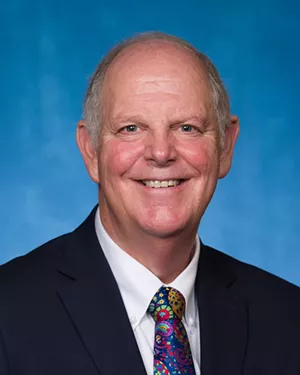
O'Halleran represents Arizona's Congressional District 1, the state's largest, which spans from suburban Phoenix to Flagstaff and the Navajo Nation.
He serves on the House Energy and Commerce Committee and regularly introduces pro-renewable-energy legislation, including the Solar Vets Act, which provides training programs for veterans to enter the solar industry in Arizona.
The outspoken pro-solar politician said neither APS nor SRP schemed against his two campaigns in 2016 and 2020. He believes they share his vision for a future powered by solar energy but disagree only on the timeline.
"It's good that they're under more scrutiny," said Fanshaw, the solar advocate. "It influences SRP to be more accepting of the fact that customers want to go solar."
Buyer's Remorse
Even among the few Arizonans who took the plunge and invested in rooftop solar, the great majority of whom live in the Valley, there is regret.
Some customers wish they stuck with a conventional utility plan.
President Joe Biden recently decided to tack at least four more years onto tariffs imposed by Donald Trump on solar cells and panels from China, but with a caveat. The bifacial panels favored by utility-scale developers, which were nascent when the tariff was first imposed but now dominate large-scale projects, are exempt.
That means more solar power plants servicing homes, but less energy independence.
And that helps to keep the thumb of utility companies on the solar energy scale in Arizona, Gordon said.
She paid $30,000 for her system, which is close to the average cost in Arizona.
"It wasn't the greatest investment," she admitted.
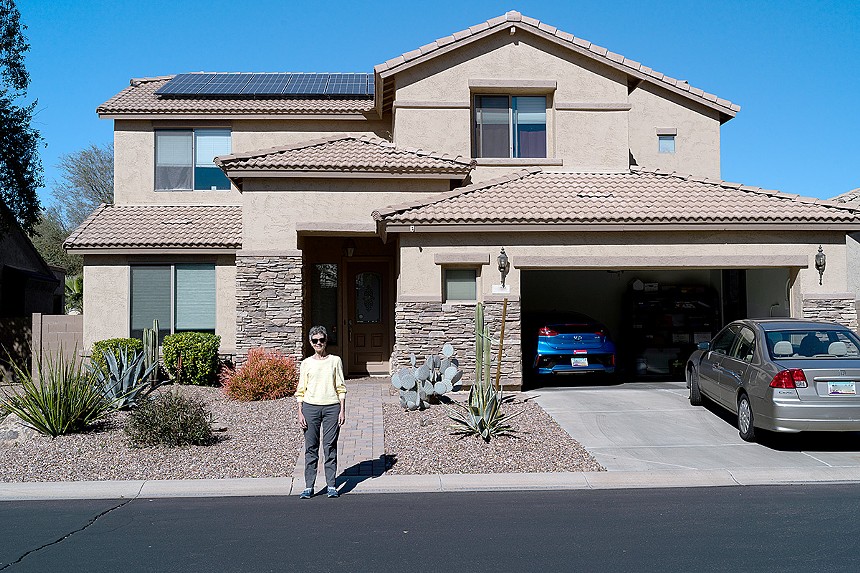
She and her husband bought solar panels for their Mesa home on the SRP grid in 2020 for financial reasons, but "it's not proving to be that way," she said.
"That has been very frustrating. The metering pays almost nothing."
Because she can afford it and wants to keep carbon out of the atmosphere as the state gets dryer, Gordon is content with her solar panels. But there is no longer a financial incentive, she said.
Advocates concur.
"If you have solar for SRP, you're doing it for environmental reasons, not to save money," Fanshaw said. "And that's too bad."
But solar industry executives disagree.
Aaron Baker, who owns and operates Ironman Solar out of Goodyear, still sees a financial benefit to going solar.
As solar buyback credit has eroded, the price of solar panels has also decreased. Selling solar is no harder now than it was when Baker founded the company in 2019, he said.
That's not to say it's easy.
"It's a very cutthroat industry," he said. "People can put whatever price tag they want on this thing."
Solar energy systems can cost over $100,000 and are only an option for homeowners.
But it's "fear of the unknown" that discourages most potential customers from pulling the trigger, Baker said.
Arizonans lack confidence in rooftop solar because the powers at be have tried to keep it out of the state, like when APS campaigned against pro-solar candidates just a few years ago.
And because solar installers are still required to connect to the grid, utility companies constantly loom over small business owners like Baker who are trying to help neighbors achieve energy independence.
"It feels like a fear tactic," he said. "It's like, 'Don't bash us or you can't have a business.'"
SRP officials explained that the company has a program to make the process to install solar easier for its ratepayers with a preferred solar installer list that has qualified companies.
"SRP's focus continues to be ensuring SRP pricing policies are equitable for our entire customer base," Garcia-Likens, SRP's representative said. "We do this while continuing to support new technologies as well as solar customers who generate some of their own power and only need retail energy during certain parts of the day such as when the sun is down."
And people harbor distrust for solar salesmen because underqualified, undertrained installers have tried to cash in on the somewhat unregulated world of selling solar, Baker said.
That's exactly what happened to Stefanie Werner, who moved to Phoenix in 2020 and bought solar panels for her new house.
"I just want to pack the entire system up and return it," she said.
Werner shelled out $68,000 to another local company for a solar setup. Nearly a year later, it's still not up and running properly.
"In the current employment climate in Arizona, I can see there's a lack of training," she said.
No, going solar isn't a guarantee that any SRP customer will save money, says Chandler-based solar consultant Sam Friedberg.
"Sometimes it does make sense, sometimes it doesn't," he said.
Soaking Up the Sun
But it's not a negative experience for everyone.
Edward Youssef installed solar shingles — a system of small solar panels that cover the entire roof — on his Gilbert home just last month, and he's already seeing a positive financial impact, he said.
That's despite the system, created by Tesla, costing him over $100,000.
He eyed solar since he moved to the Valley in 2008, but SRP rates made it infeasible to make the leap until saved up the capital for this totally off-the-grid system, he said.
"It's like price-gouging," Youssef said of SRP's rates for solar customers. "It's not affordable for most Arizonans."
It "sounded like a nightmare" to commit to solar before he could afford to break up with SRP, he said.
But Youssef loves solar. And he believes in it.
He was excited to see last week's federal court ruling against SRP and hopes, like Baker, that state legislators will begin mandating solar panels on new homes.
"Arizona is one of the sunniest places in the world," Youssef said. "It's ludicrous that we don't do more solar. Frankly, it's insulting."
On the Horizon
APS is making one local effort to add renewable energy to its portfolio.
Officials at the Bureau of Land Management are reviewing three applications to put utility-scale solar energy projects on public ground in Maricopa County. The 1500 megawatt project split across three solar farms would be built just north of Gila Bend, northwest of the White Tank Mountains, and south of State Route 238 near the Pinal County line.
If built, the solar projects "could supply large quantities of homes," said Chris Wonderly, BLM's spokesperson in its Phoenix office.
On January 20, applicants heard the public's cultural, economic, and ecological concerns.
The largest of the three projects, Western Tiger Solar, would be operated by APS.
"The comments received were neither for nor against any specific project," Wonderly said. As such, the projects are expected to advance.
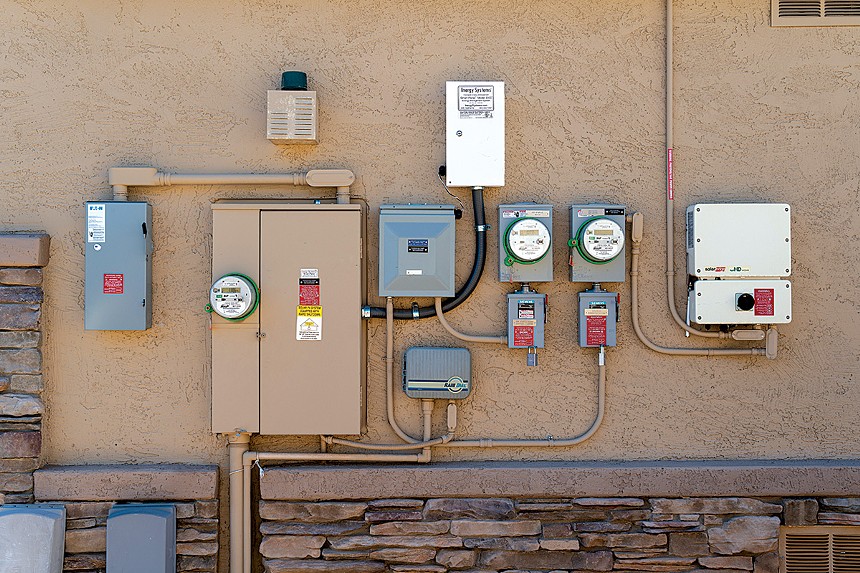
The next step is yet another review process to determine if the projects are in line with environmental law, a process that could take two years.
The projects all aim to be complete by the end of 2025.
O'Halleran praised utility companies for their efforts to bolster clean energy.
"Over the last three or four years, I've seen a transformational change in the future for renewable energies," he said. "That's our collective future."
But Gordon, the Mesa homeowner, sees APS snatching the freedom of solar energy from the hands of consumers.
"They have figured out how to charge us," she said. "We're essentially trapped."
No one disputes this fact: Arizona is a solar gold mine.
"Arizona is the state with the capacity to address large volumes of solar energy," O'Halleran said.
The open question is when Arizona will fully tap that vein of golden rays.
Baker, the entrepreneur, foresees solar energy as the norm in just two or three years.
The early adopter phase is over, and the abyss of, "Do I do it? Do I not?" is nearly over, he predicts. Soon, you'll be the odd man out if you don't have solar panels on your roof in the Valley.
"One day, everyone will have solar," Baker said. "But until it's mandated, a lot of people aren't going to do it."
Energy Innovation, a nonpartisan think tank, estimates federal policies pushing for 80 percent of American electricity to be renewable would create tens of billions of dollars in solar projects in Arizona.
Progressive legislators don't want to wait for mandates.
"We always need to think about not just today, but the future," O'Halleran said. "Today's investments will put us in a position to make us a leader in the world. And that includes solar panels."


